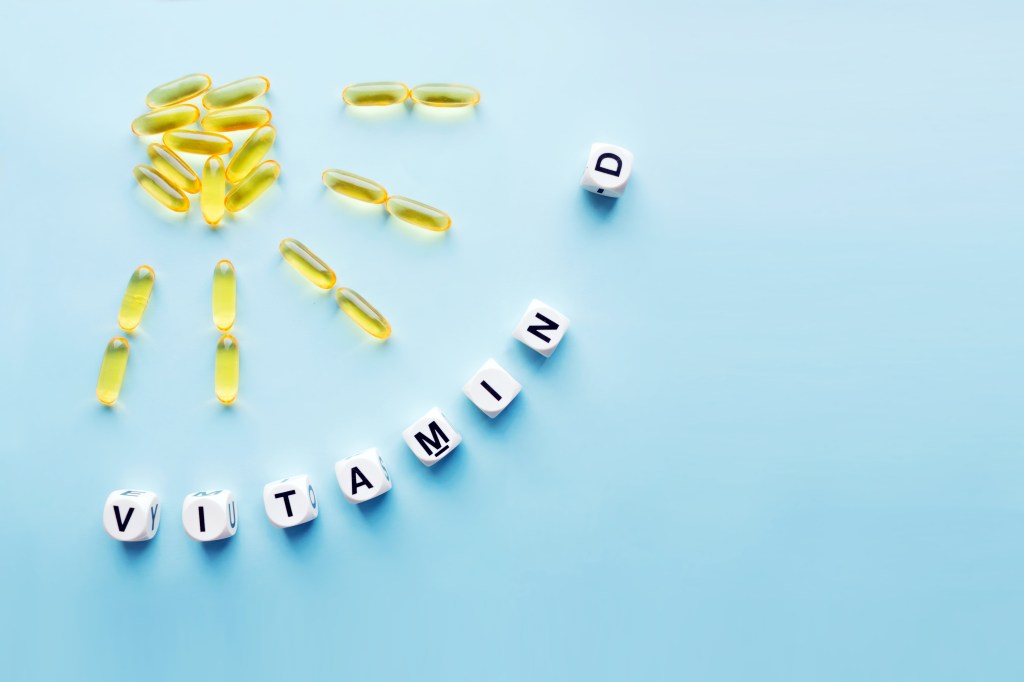At a glance
While you can produce some vitamin D on a cloudy day, cloud cover reduces UVB exposure, limiting vitamin D production. While sunlight remains the most effective source, supplementation with vitamin D3 may be beneficial to support healthy levels when sunlight is insufficient.
It’s well known that sun exposure triggers vitamin D production, but can you get vitamin D on a cloudy day?
Yes, it’s possible to absorb vitamin D on a cloudy day. However, how much vitamin D your body can produce depends on many factors, including your age, skin tone, geographical region, and health status.
Learn how to promote optimal vitamin D levels by maximizing vitamin D production on cloudy days.

What is vitamin D?
Vitamin D, also known as the sunshine vitamin, is a fat-soluble vitamin that’s naturally produced when the skin is exposed to ultraviolet B (UVB) radiation in sunlight.
Vitamin D maintains various physiological functions and plays a critical role in calcium balance, bone health, immune system function, and neurotransmitter balance.
Research published in the Journal of Clinical Investigation found that nearly all cell types in the human body possess vitamin D receptors, suggesting that vitamin D influences and regulates a wide range of cellular and metabolic processes.
Vitamin D is stored predominantly in the liver and fat cells, and these reserves help maintain balanced levels during short periods without adequate sunlight exposure.
However, an extended lack of UVB radiation can deplete the body’s vitamin D stores and increase the risk of deficiency.
Watch the video below to learn how much sun you need to get enough vitamin D.
How does sunlight produce vitamin D?
UVB rays can penetrate the outermost layer of the skin, where they trigger a photochemical reaction that converts 7-dehydrocholesterol to cholecalciferol, also known as previtamin D3.
Previtamin D3 enters the circulation and undergoes enzymatic conversion in the liver and kidneys, which activates vitamin D3 into a form that can easily be utilized by the body.
Factors that influence vitamin D production
According to a factsheet published by the National Institutes of Health (NIH), exposing the face, arms, and legs without sunscreen to sunlight for 5 to 30 minutes, once or twice per week, is generally considered adequate to maintain a healthy vitamin D3 status.
However, it’s important to note that several factors influence how much vitamin D the body can synthesize in response to UVB radiation.
Geographical locations at higher latitudes north of the equator tend to receive insufficient UVB radiation to produce optimal vitamin D, especially during the winter months.
The skin’s ability to produce vitamin D from sunlight decreases with age, which explains why older adults are at a higher risk of low vitamin D status.
Vitamin D production relies on adequate amounts of cholesterol, and individuals on a low-fat diet or those taking cholesterol-lowering drugs can develop imbalanced vitamin D levels.
In addition, skin color can affect vitamin D. Darker skin tones contain more melanin, a pigment that determines skin color. Melanin has been found to negatively impact vitamin D production, and individuals with darker skin pigmentation are at increased risk of vitamin D deficiency.
This has been confirmed by research published in Heart and Circulatory Physiology, highlighting, “Darkly pigmented individuals are at the greatest risk of hypovitaminosis D.”

Can you get vitamin D on a cloudy day?
Yes, you can still get some vitamin D on a cloudy day.
While cloud cover filters some of the UV rays from the sun, it doesn’t block all UVB radiation, which explains why you can still produce small amounts of vitamin D on an overcast day.
It’s important to note that thicker cloud cover may significantly reduce UVB radiation, whereas thinner clouds typically allow for more vitamin D production.
How to maximize vitamin D production on cloudy days
How much vitamin D your skin can produce on cloudy days depends on your location, age, skin tone, and health status.
However, there are several steps you can take to maximize vitamin D production.
Exposing more bare skin to UVB radiation can enhance vitamin D production on cloudy days.
While sunscreen is crucial to prevent skin cancer, skin care products with a sun protection factor (SPF) of eight or above block around 95 percent of UVB rays, and short periods of sun exposure without sunscreen can boost vitamin D production.
Spending time outdoors during peak sunlight hours is equally important. UV radiation tends to be the highest between 10:00 a.m. and 4:00 p.m., which increases the amount of UVB rays that can penetrate the cloud cover and stimulate vitamin D production.

Alternative sources of vitamin D
“Although sunlight exposure is the most natural way to obtain vitamin D, many factors can impair its production, which explains why vitamin D deficiency is so widespread,” explains Dr. Berg.
Research published in the International Journal of Health Sciences suggests that almost half of U.S. adults are at risk of vitamin D deficiency.
While certain foods, such as fatty fish, cod liver, egg yolks, and beef liver, contain some vitamin D3, these dietary sources typically don’t offer enough vitamin D3 to maintain adequate vitamin D levels.
Vitamin D3 supplements can play a beneficial role in maintaining a healthy vitamin D status, especially for individuals at increased risk of deficiency.
If you live in a region with limited sunlight or have concerns about not getting enough vitamin D, it’s recommended to consult a healthcare provider.
A doctor can perform a simple blood test to evaluate your vitamin D status and formulate an appropriate therapeutic approach to support healthy levels.
Key takeaways
- Because UVB rays are partially blocked by clouds, vitamin D production can be reduced on overcast days.
- Older adults, individuals with darker skin tones, and those living in northern latitudes may be at higher risk of low vitamin D levels.
- Direct sunlight exposure between 10 a.m. and 4 p.m. helps maximize vitamin D production.
- While short periods of sun exposure without sunscreen can help optimize vitamin D production, sunscreen use is crucial for long-term skin health.
FAQ
1. Can you absorb vitamin D when it’s cloudy?
Yes, you can absorb some vitamin D when it’s cloudy. However, clouds filter ultraviolet B (UVB) rays needed to trigger vitamin D production, and how much vitamin D your body can produce on a day with overcast conditions depends on the cloud cover thickness and your age, skin tone, and health status.
2. Can you get vitamin D while in the shade?
While some UVB rays can reach shady spots, the amount of UVB radiation that reaches the skin in the shade is significantly lower compared to direct sunlight. If you are seeking to increase your vitamin D levels, it’s recommended to spend time in direct sunlight.
3. Do you need to be in direct sunlight to get vitamin D?
Direct sunlight exposure is the most effective way to stimulate vitamin D production.
While some UVB rays can penetrate cloud cover and reach shady spots, they may not be sufficient to stimulate adequate vitamin D production, which can increase the risk of vitamin D deficiency.
4. What is the best time to go outside for vitamin D?
The peak hours for optimal vitamin D production are between 10 a.m. and 4 p.m. During this time, the sun is at its highest angle, allowing the maximum amount of UVB radiation to reach the Earth’s surface.
5. How do you get vitamin D when it’s not sunny?
Taking vitamin D3 supplements under medical supervision can be an effective way to promote healthy vitamin D levels and prevent deficiency.
6. Does the weather affect vitamin D production?
Yes, the weather can affect vitamin D production. Heavy cloud cover and fog can significantly reduce the amount of UVB radiation reaching your skin, leading to a reduced rate of vitamin D production.
In contrast, a clear day with plenty of sunshine allows for maximum UVB radiation and optimal vitamin D production.
7. Can I still get vitamin D from the sun if I wear sunscreen?
Sunscreen with a sun protection factor (SPF) of eight or higher blocks almost 95 percent of vitamin D production.
While sunscreen use is important for safe sunbathing and to prevent skin cancer development, it’s recommended to expose your bare skin to sunlight without sunscreen for limited periods to maximize vitamin D production.








